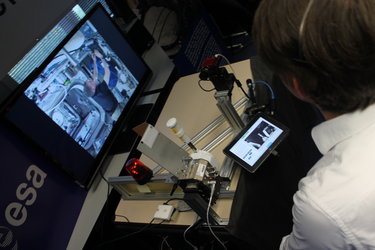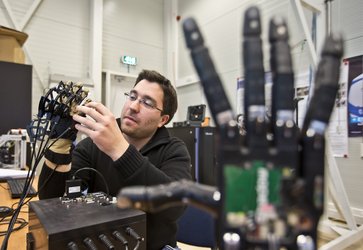Accept all cookies Accept only essential cookies See our Cookie Notice

About ESA
The European Space Agency (ESA) is Europe’s gateway to space. Its mission is to shape the development of Europe’s space capability and ensure that investment in space continues to deliver benefits to the citizens of Europe and the world.
Highlights
ESA - United space in Europe
This is ESA ESA facts Member States & Cooperating States Funding Director General Top management For Member State Delegations European vision European Space Policy ESA & EU Space Councils Responsibility & Sustainability Annual Report Calendar of meetings Corporate newsEstablishments & sites
ESA Headquarters ESA ESTEC ESA ESOC ESA ESRIN ESA EAC ESA ESAC Europe's Spaceport ESA ESEC ESA ECSAT Brussels Office Washington OfficeWorking with ESA
Business with ESA ESA Commercialisation Gateway Law at ESA Careers Cyber resilience at ESA IT at ESA Newsroom Partnerships Merchandising Licence Education Open Space Innovation Platform Integrity and Reporting Administrative Tribunal Health and SafetyMore about ESA
History ESA Historical Archives Exhibitions Publications Art & Culture ESA Merchandise Kids Diversity ESA Brand Centre ESA ChampionsLatest
Space in Member States
Find out more about space activities in our 23 Member States, and understand how ESA works together with their national agencies, institutions and organisations.
Science & Exploration
Exploring our Solar System and unlocking the secrets of the Universe
Go to topicAstronauts
Missions
Juice Euclid Webb Solar Orbiter BepiColombo Gaia ExoMars Cheops Exoplanet missions More missionsActivities
International Space Station Orion service module Gateway Concordia Caves & Pangaea BenefitsLatest
Space Safety
Protecting life and infrastructure on Earth and in orbit
Go to topicAsteroids
Asteroids and Planetary Defence Asteroid danger explained Flyeye telescope: asteroid detection Hera mission: asteroid deflection Near-Earth Object Coordination CentreSpace junk
About space debris Space debris by the numbers Space Environment Report In space refuelling, refurbishing and removingSafety from space
Clean Space ecodesign Zero Debris Technologies Space for Earth Supporting Sustainable DevelopmentLatest
Applications
Using space to benefit citizens and meet future challenges on Earth
Go to topicObserving the Earth
Observing the Earth Future EO Copernicus Meteorology Space for our climate Satellite missionsCommercialisation
ESA Commercialisation Gateway Open Space Innovation Platform Business Incubation ESA Space SolutionsLatest
Enabling & Support
Making space accessible and developing the technologies for the future
Go to topicBuilding missions
Space Engineering and Technology Test centre Laboratories Concurrent Design Facility Preparing for the future Shaping the Future Discovery and Preparation Advanced Concepts TeamSpace transportation
Space Transportation Ariane Vega Space Rider Future space transportation Boost! Europe's Spaceport Launches from Europe's Spaceport from 2012Latest

Haptics-2 experiment
Thank you for liking
You have already liked this page, you can only like it once!
This deceptively modest force-feedback joystick in ESA’s Telerobotics Laboratory is set to become a piece of space history.
On Wednesday evening NASA astronaut Terry Virts will move an identical joystick in Europe’s Columbus module of the International Space Station, and this slaved joystick – sitting in ESA’s ESTEC technical centre in Noordwijk, the Netherlands – will move in exactly the same way.
Next, someone on the ground will grab this joystick and Terry will feel the force and movement up on the Station.
This historic first ‘handshake’ from space is part of the Lab’s Haptics-2 experiment, testing systems to transmit the human sense of touch to (and from) space for advanced robot control.
As a follow-up in the 40-minute orbital session, the terrestrial joystick will be moved against a variety of materials of differing stiffness, to test if its force-feedback is sufficiently sensitive for its human subject to differentiate hard metal from soft foam.
The deceptively simple experiment requires sophisticated control software, not least because the signal between the Station and ESTEC will be relayed via satellites some 36 000 km over the equator, as well as through NASA’s ground system.
So the users on each side will have to contend with a signal lag or ‘latency’ of around 0.8 seconds as each data packet travels from the Station to the satellite, to the ground, to ESTEC and back up to the Station.
The danger is that packet loss and data communication disruption could lead to excessive force, so advanced control software will help to compensate and keep the two sets of equipment safe and in sync.
In addition, the space element includes an augmented reality view of an overlay arrow on the realtime video stream to indicate the direction and degree of force being used on ground.
One day, astronauts orbiting Mars might use evolved versions to control rovers on the ground to perform human-like tasks on the surface – without being there. Speeding along in orbit means the degree of latency will constantly shift, too, so ESA’s telerobotics team have designed a system to compensate as needed.
Tests using this direct but changing view between controller and target will be carried out later this year.
(For information on the 03 June 2015 experiment results, see this link.)
-
CREDIT
ESA-M. Aiple -
LICENCE
ESA Standard Licence

Haptics-2 on Earth

Andreas Mogensen tests Haptics-1

Telerobotic robot hand

Astronaut training: Haptics/Interact - Interact Protocol 2















 Germany
Germany
 Austria
Austria
 Belgium
Belgium
 Denmark
Denmark
 Spain
Spain
 Estonia
Estonia
 Finland
Finland
 France
France
 Greece
Greece
 Hungary
Hungary
 Ireland
Ireland
 Italy
Italy
 Luxembourg
Luxembourg
 Norway
Norway
 The Netherlands
The Netherlands
 Poland
Poland
 Portugal
Portugal
 Czechia
Czechia
 Romania
Romania
 United Kingdom
United Kingdom
 Slovenia
Slovenia
 Sweden
Sweden
 Switzerland
Switzerland

























